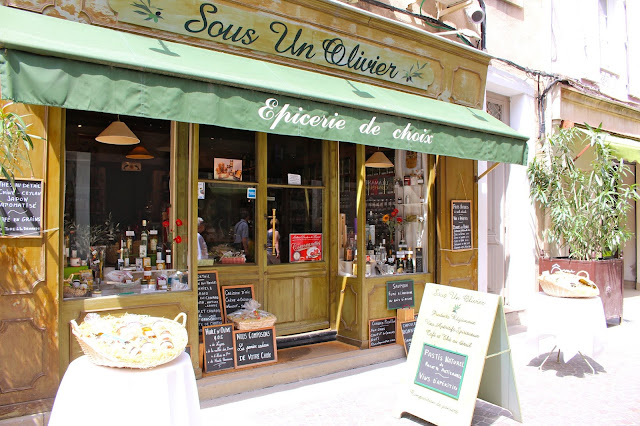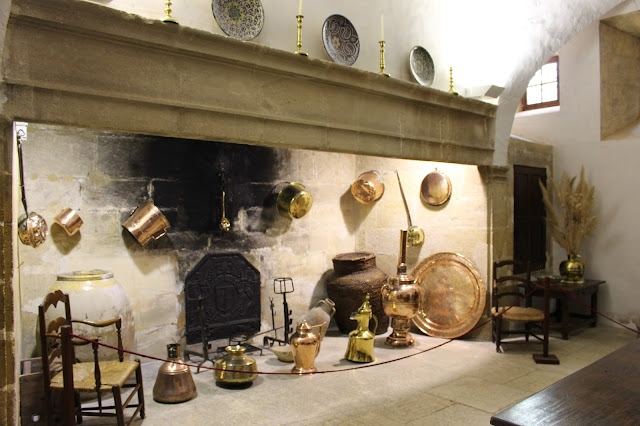Dubbed ‘Étoile de Provence’ (Star of Provence), jewel-box Moustiers Ste-Marie crowns towering limestone cliffs, which mark the beginning of the Alps and the end of Haute-Provence's rolling prairies.
A 227m-long chain, bearing a shining gold star is stretched high above the village—a tradition, legend has it, by the Knight of Blacas, who was grateful to have returned safely from the Crusades. Twice a century, the weathered chain snaps, and the star gets replaced, as happened in 1996.
We are staying at La Ferme Rose, an inviting converted farmhouse, now a three-star hotel which contains quirky collectibles like a Wurlitzer jukebox and a display case of coffee grinders.

When silver was reclaimed by Louis XIV and melted for war, Moustiers' decorative faïence (glazed earthenware) graced the dinner tables of Europe's palaces.

Maybe not these guys.
Antique masterpieces are housed in the little Musée de la Faïence.
Today, each of Moustiers' 15 ateliers has its own style—from representational to abstract.

Lording over the village, beneath Moustiers' star, 14th-century Chapelle Notre Dame de Beauvoir clings to a cliff ledge like an eagle's nest. A steep trail climbs beside a waterfall to the chapel, passing 14 stations of the cross en route.
Everyone needs a break after climbing the steep steps to the church.

What goes up, must come down.


A stunning sunset over Moustiers Ste-Marie.
Just south-west of Moustiers, the emerald-green waters of Lac de Ste-Croix are a reservoir formed in 1974 with scads of watercraft, windsurfers, canoes and kayaks to rent.
It's not quite the Cannes-sized yacht Tim dreams of but it will have to do for now.
“I'm pretending I'm Bond, James Bond, and it's a Q-Boat.”
“Honey, Ryder a little faster s'il vous plaît.” “I can't—you know this tub only goes 3 mph!”
Tourtour is a beautiful, amber-stoned village with a churchyard stretching across a promontory offering panoramic views. We stop for a coffee and a stroll through the cobbled lanes.
The village of Entrecasteaux, with its giant 17th century château, old stone houses sun-baked every shade of gold, and fountain-clad square, perches dramatically over a river.
Lunch with the locals at Bar Central.

A moat of flowing river encircles the ‘Venice of Provence’, L'Isle-sur-la-Sorgue, with picturesque waterwheels trailing dripping green moss.
L'Isle-sur-la-Sorgue dates to the 12th century, when fishermen built huts on stilts above what was then a marsh. By the 18th century, canals lined with 70 giant water wheels powered silk factories and paper mills.

L'Isle-sur-la-Sorgue's material draw is its upmarket antiques shops where it is fun to nose around even if you're not buying. Olive oil is the keystone to Mediterranean cuisine. It moistens every salad, drizzles croutons and cheeses, fries fish and onions, and bakes summer fruit.
If you've ever wondered what to do with your old gum boots, here's your answer.
The Collégiale Notre Dame des Anges, whose stately exterior offers no clue of the Baroque theatrics inside—122 gold angels ushering the Virgin Mary; and a magnificent 1648-built organ.

Rolling hills dotted with ancient villages define the Luberon Valley. Lush with fruit trees and vineyards, its colours, fragrances and flavour change seasonally. Criss-crossed by country lanes, walking tracks and cycling routes, it is where you come to immerse yourself in nature. And to eat.
Like a giant wedding cake rising over the Rivers Sorgue and Calavon, the tiered village of Gordes sits spectacularly on the white-rock face of the Vaucluse plateau.
A hidden side to Gordes is revealed in the Caves du Palais Saint-Firmin, a large, underground network of cellars, mills, vats and stone carves dating from the 11th century.
Gordes' star attraction is its 11th-century château.
Famously framed by lavender in July, the exterior of the isolated Cistercian abbey, the Abbaye Notre-Dame de Sénanque, 4 km northwest of Gordes, appears on every postcard rack in Provence.
The abbey was founded in 1148 and remains inhabited by monks.
You'll spot beehive-shaped bories while buzzing around Provence—1610 have been counted to date. In the Village de Bories, 4 km southwest of Gordes, bories constructed of slivered limestone were built during the Bronze Age, inhabited by shepherds until 1839, then abandoned until their restoration in the early 1970s.
Silk and paper-making were both big business here.
Pilgrims come from all over to follow the Route de la Lavande, tracking Provence's aromatic purple flower. In bloom from June to August, it usually hits peak splendour in late July. You can cruise the fields, visit mountainside distilleries or scoop up all things lavender at abundant local markets.

Two millenia ago, the Romans used ochreous earth around Roussillon to make pottery glaze. Today the hilltop village is defined by colour: it's a requirement that villagers tint the façades of their homes with ochre—some 40 different shades, from beige to purple.
At the edge of the village, groves of chestnut and pine surround sunset-coloured ochre formations, rising on a cliff.
A 30-minute to hour-long walk, the Sentier des Ocres, wends through stunning mini-desert landscapes—it's like stepping into a Georgia O'Keefe painting.
Avoid wearing white.
In Provence, the cicada beetle is supposed to bring good luck and happiness.
Scaling steep streets to Ménerbes rewards you with uninterrupted views over Tuscan-like plains. The village's maze of cobbled alleyways lead to a 12th-century church, and a delicious locale to taste wine.
Ménerbes was made famous by British ex-pat author Peter Mayle, whose books A Year in Provence, Toujours Provence and others, recount his tales of renovating a farmhouse outside the village in the late 1980s.
It's name is unrelated to the brand, but Lacoste, 6.5km west of Bonnieux, does have couturier connections. In 2001 designer Pierre Cardin purchased the 9th-century Château de Lacoste (and much of the village), where the notorious Marquis de Sade retreated in 1771, when his writings became too scandalous for Paris.
The château, where de Sade hosted notorious orgies, was eventually looted by revolutionaries in 1789, and the 45-room palace remained an eerie ruin until Cardin arrived.
He created a 1000-seat theatre and opera stage adjacent, open only during July's month-long Festival de Lacoste.
“I love you thi-i-i-i-i-is much!”
Navigating Bonnieux is a little jigsaw puzzle in itself. The tiered village straddles several levels: from place de la Liberté, 86 steps lead to 12th-century Église Vieille du Haut.
The village has a history of good bread.
It's a dog's life.
Leaving Bonnieux.
Six kilometers south of Bonnieux is the dense, fragrant Forêt des Cèdres, a protected cedar forest with staggering vistas and a lush botanical trail, which is shady and cool in summer.
We arrive in Lourmarin in time for lunch. The goat cheese salads in France are the best in the world.

At the base of the Combe de Lourmarin and easily accessible, the alluring village of Lourmarin makes for a lovely stroll.
Unlike many Luberon villages, its pretty streets are flat.
The Château de Lourmarin—the first of its kind built in Provence—is a magnificent sight that dominates the village. Originally a 12th-century fortress, it was extended in the 15th century. The Renaissance wing, added in the 16th century, contains some of the most impressive rooms, with wonderfully elaborate fireplaces and a grand stone staircase.
The surrounding landscaped gardens and olive groves add to the beauty of the place.
On the road again, to Aix-en-Provence and Marseilles.













































































































































No comments:
Post a Comment